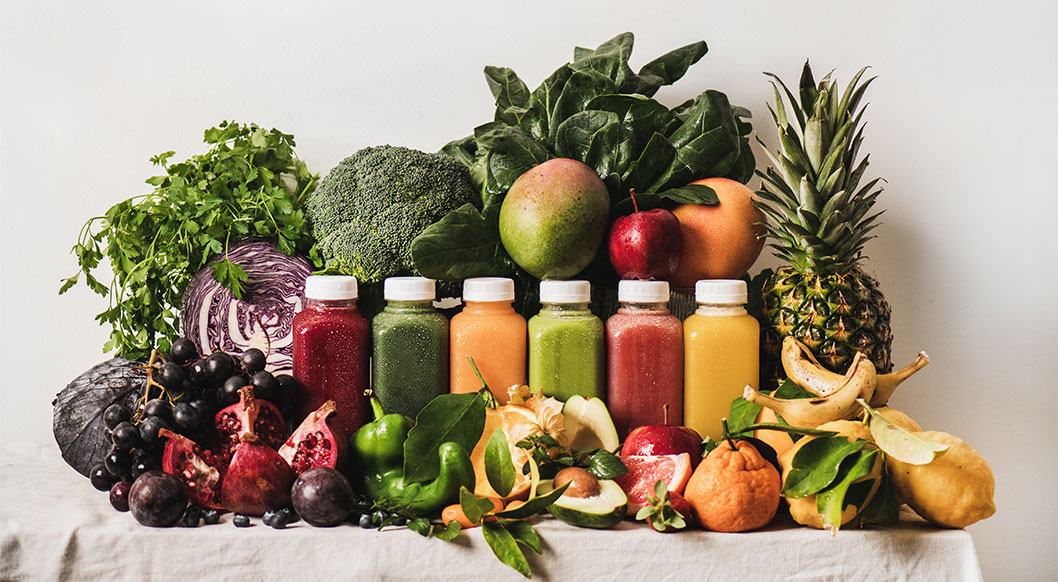Whether you’re trying to tone up, slim down or simply stay healthy, there’s a smoothie for that. Because they’re so customizable, you can adjust the ingredients and portion sizes in your smoothies to help achieve a range of health goals, and they can be a key part of a healthy diet. No food — including smoothies — is the magic bullet for health, though, and you’ll need to follow a balanced diet for the best long-term results, rather than following a fad diet that includes too many smoothies.
Benefits of Smoothies on a Diet
Smoothies are a convenient and healthy addition to a diet. They’re a great way to increase your protein intake and get more fruits and veggies into your diet — and to “hide” veggies if you don’t like the taste of them on their own. You can freeze smoothies ahead of time and enjoy them on-the-go, so you aren’t forced to hit the drive-thru or vending machine on days when you don’t have time for a sit-down meal. Plus, they’re completely customizable to suit your food preferences and prevent boredom. And because you can scale the portion size up or down — and add or omit high-calorie ingredients — you can fit smoothies into any size diet.
To reach your goals, though, you’ll need to follow a diet tailored to your individual fitness goals. If you’re dieting to lose weight, that means eating 500 to 1,000 calories less than you burn each day, so you’ll be able to burn 3,500 to 7,000 extra calories weekly — enough to lose 1 to 2 pounds.
Include Healthy Greens and Berries
Make diet-friendly smoothies with lots of green veggies, along with lower-calorie fruit options, like berries. Berries are typically lower in sugar and calories than other fruits — a cup of sliced strawberries or whole cranberries, for example, has roughly 50 calories, while a cup of pineapple has 84 calories. Berries are also high in fiber — strawberries provide 13 percent of the daily value per cup, while cranberries supply 18 percent. Even if you didn’t make other changes to your diet, getting 30 grams of fiber daily is enough to help you lose weight, a 2015 Annals of Internal Medicine study reported.
Leafy greens also supply a small amount of fiber for weight loss: 2 and 3 percent of the daily value per cup of spinach and kale, respectively, and 6 percent of the daily value for collards. More importantly, they bulk up your smoothie without many calories. A cup of greens has about 10 calories, a negligible amount even in a highly restrictive 1,200-calorie diet.
Step Up Your Protein Intake
Add protein to your smoothies to help you get the most from your diet. Protein is a key nutrient for weight loss; it requires more energy to digest than fat and carbs, which means you’ll burn more calories breaking down your food, and it also boosts meal satisfaction to curb hunger. Protein powders — including whey, soy, casein or brown rice — can boost your protein intake, but you don’t need to shell out for supplements if you don’t want to. A 4-ounce portion of cottage cheese, for example, adds 13 grams of protein to your smoothie, a 3-ounce slice of silken tofu adds 4 grams, and a 6-ounce container of Greek yogurt adds 17 grams. The leafy greens abundant in your smoothies also contribute small amounts of protein to your drink; each cup of spinach, collards or kale contains about 1 gram of protein.
Thicken Your Smoothie for Satiety
When it comes to satiety from your smoothies, texture matters. A study, published in PLoS One in 2014, found that people who drank a slightly thickened smoothie in the morning ate less for lunch than those who drank a regular smoothie. Thicken your smoothies with flaxseed and chia to boost your satisfaction. Both seeds contain soluble fiber, which forms a gel when it combines with water, making your smoothie thicker and creamier. They’re also high in omega-3 fatty acids — heart disease-fighting fats that you need as part of your diet — and supply fiber and protein to keep you full. A tablespoon of ground flaxseed, for example, has 2 grams of fiber and 1 gram of protein; a half-ounce of chia seeds has 5 grams of fiber and 3 grams of protein.
Experiment with different blending methods to make your smoothie thicker, too. Try adding half your frozen fruit when the smoothie is already partially blended — you’ll get a few small chunks of fruit, which can make your smoothie “chewier.” Or add a handful of ice cubes to get a thicker, icier smoothie without adding extra calories.
Add Low-Calorie Flavorings
Spice up your smoothie and add variety with low-calorie seasonings. Certain spices and add-ins can help you prevent boredom, and they add flavor to your drink so you don’t need to turn to sugary or fatty additions. Get your chocolate fix, for example, by adding a tablespoon of cocoa powder to your smoothie — it has just 11 calories. Cocoa powder also offers some nutritional benefits; it supplies 8 percent of the daily value for fiber, offers small amounts of minerals like manganese and copper, and is packed with beneficial antioxidants.
Adding cinnamon to your smoothie can also create the illusion of more sweetness without adding a significant amount of calories. Or spice up a smoothie with a pinch of cayenne or spicy red pepper; it might help reduce your appetite, noted a study published in Physiology and Behavior in 2011.
Diet Smoothies to Try
Start your day with a diet-friendly green breakfast smoothie. Simply blend together nonfat milk, 1 cup of chopped spinach, stems removed; a cup of frozen berries; and a tablespoon of flaxseed for a smoothie with 180 calories. As you get used to the taste of green smoothies, try upping the amount of leafy greens to 2 or 3 cups, and go for stronger-tasting greens, like kale. Make the smoothie thicker by adding an extra spoonful of ground flaxseed, or get more protein by adding Greek yogurt or a scoop of protein powder.
Try dessert-inspired smoothies to help satisfy your sweet tooth without breaking your diet. A mixture of vanilla-flavored almond milk, a cup of frozen cranberries, a spoonful of flaxseed, a teaspoon of cinnamon and a few drops of liquid stevia blends into a “cranberry crumble” smoothie that has roughly 175 calories. For a citrusy twist, add a few drops of orange extract or a little orange zest. A cup of vanilla almond milk blended with a small frozen banana, a handful of spinach and pinch of cinnamon makes a tasty “banana bread” smoothie with roughly 195 calories. Or satisfy your chocolate craving with a smoothie made from a cup of nonfat milk, frozen strawberries, cocoa powder and red pepper flakes for a fiery “chocolate-covered cherry” smoothie that’s rich in antioxidants and supplies around 150 calories.
Creating a Balanced Diet
While smoothies can help you get more nutrients and contribute to a healthy diet plan, your meals shouldn’t revolve around drinking smoothies all day as a replacement for your meals. A diet plan based solely or heavily on smoothies, to the exclusion of other healthy foods, counts as a fad diet, according to the University of Wisconsin. While drinking smoothies for each meal could theoretically allow you to lose weight — as long as you create a calorie deficit — you won’t develop the cooking skills and appreciation for healthy foods you’ll need for long-term success. Once you go off the smoothie-only diet — which you will, because it’s not sustainable — you’re more likely to go back to your old diet habits and regain the weight.
Instead, use smoothies as part of a well-balanced diet. If you enjoy an on-the-go smoothie for breakfast, try a spinach salad with salmon or a turkey, lettuce and tomato sandwich on whole-grain bread for lunch, then some grilled tuna, quinoa and roasted veggies for dinner. Or if you go for a filling smoothie at lunchtime, made sure you had a healthy breakfast — like scrambled eggs with veggies, or oatmeal with fruit — and a regular healthy meal, like a chicken stir-fry, for dinner.
If you’re worried you’re relying too heavily on smoothies for weight loss, consult a nutrition professional who can help develop a weight loss meal plan that suits your tastes, cooking skill and timetable.







0 Comments